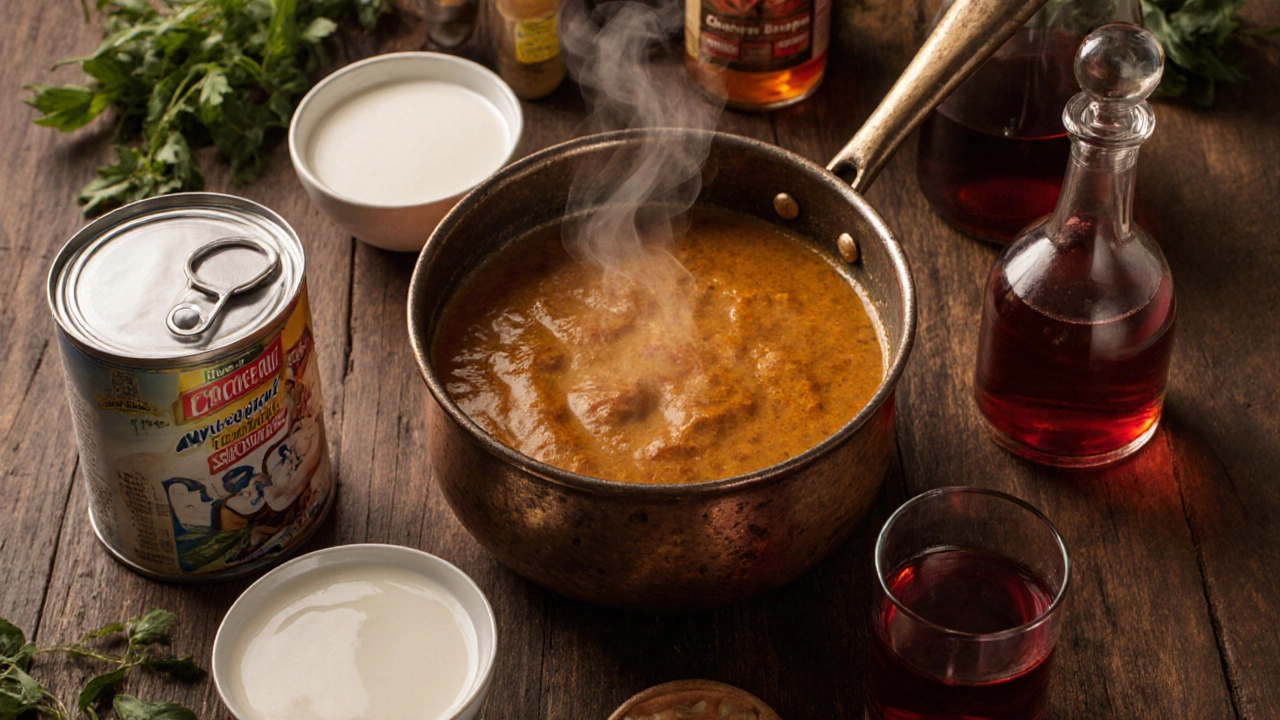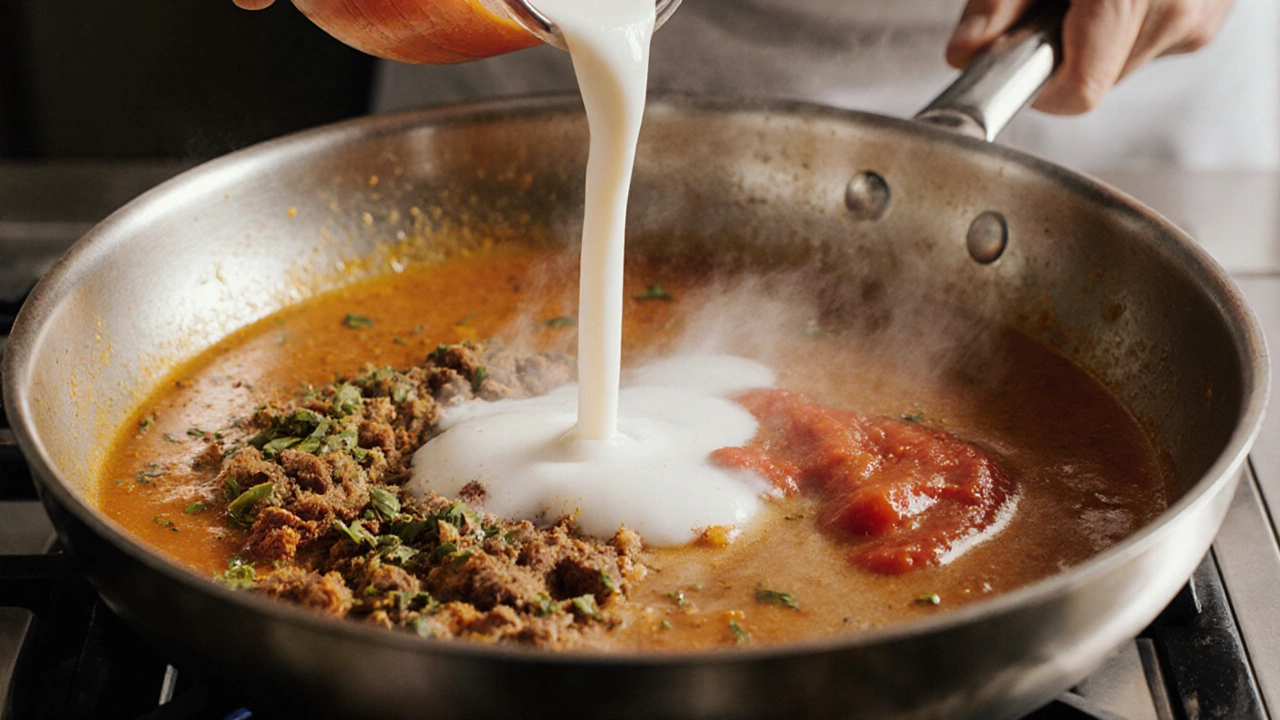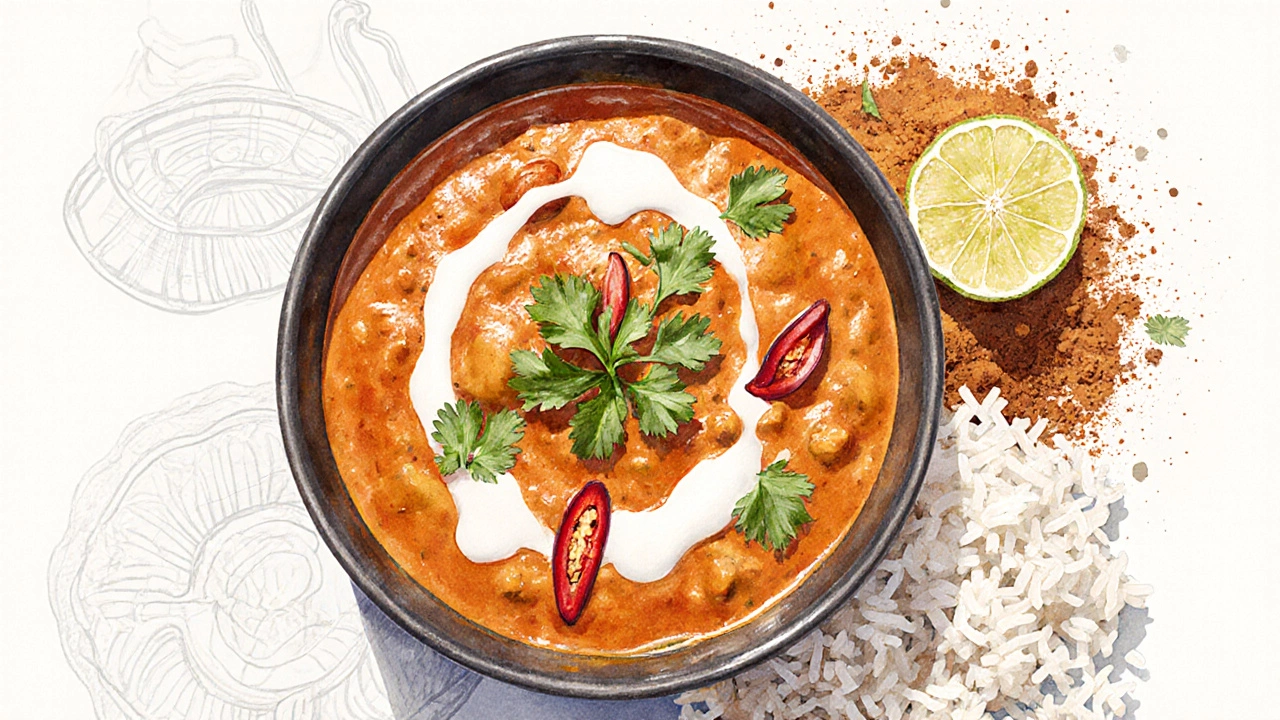Best Liquids to Add to Curry for Perfect Consistency & Flavor
 Oct, 10 2025
Oct, 10 2025
Curry Liquid Selector
Liquid Options
Coconut Milk
Rich, creamy, sweet-savory. Great for Thai, South Indian, and seafood curries.
Yogurt
Tangy, cooling. Ideal for North Indian kormas and marinades.
Broth
Umami-rich, neutral flavor. Works well in chicken tikka masala and light veg curries.
Tomato Puree
Acidic, bright. Perfect for Chettinad and Punjabi butter chicken bases.
Cream
Rich, buttery. Excellent for Paneer Butter Masala and Dal Makhani.
Wine
Fruity, earthy. Adds depth to beef or lamb curries.
Choosing the right liquid for curry can turn a bland stew into a dish that sings. Whether you’re battling a sauce that’s too thick, trying to mellow a spicy heat, or need a dairy‑free shortcut, the liquid you pour in matters more than you think.
Quick Takeaways
- Use coconut milk for richness and a subtle sweet‑savory note.
- Yogurt adds tang and creaminess; whisk it in off‑heat to avoid curdling.
- Broth (chicken, beef, or vegetable) amplifies umami without changing the flavor profile.
- Tomato puree or crushed tomatoes bring acidity and body for South Indian‑style curries.
- For a bright punch, finish with a splash of citrus or tamarind water.
What Is Curry, Anyway?
When you hear the word curry is a blend of spices, aromatics, and usually a sauce base that varies across cuisines, the first thing you might wonder is what to use to achieve the perfect saucy texture. At its core, a curry starts with three things: a spice mix (garam masala, curry powder, or regional blends), a fat (oil or ghee) to bloom the spices, and a liquid to carry the flavors. The chosen liquid can make a curry feel heavy, light, creamy, or tangy - and it can also influence the final color and aroma.
Common Liquids and Their Personality
Below are the most frequently added liquids, each introduced with a brief definition and a few key attributes.
Coconut milk is a thick, fatty liquid extracted from grated coconut flesh. It brings a creamy mouthfeel, a gentle tropical sweetness, and a high fat content (about 20%fat) that rounds out heat.
Yogurt is a fermented dairy product with 3‑5%fat and a pleasant tang. It cools spice, adds a silky texture, and contributes a subtle sour note.
Broth is a clear liquid made by simmering meat, bones, or vegetables with herbs and aromatics. Depending on the base (chicken, beef, or veg), it supplies protein‑rich umami without altering the curry’s core spices.
Tomato puree is a cooked, strained blend of tomatoes that’s thick and acidic. It adds body, a bright red hue, and natural acidity that balances sweet or fatty components.
Cream is a dairy product containing at least 30%fat, often used to finish North‑Indian gravies. It makes the sauce ultra‑rich and smooth, but can mute spice if over‑used.
Wine is an alcoholic beverage made from fermented grapes, typically added in small amounts for depth. Red wine works well in meat‑heavy curries; white adds a citrusy lift.
Tamarind water is a diluted concentrate of tamarind pulp, offering a sour, slightly sweet flavor. It brightens the palate and is a classic in South Indian and Thai curries.

How to Choose the Right Liquid
Think of the decision like matching a dance partner. Ask yourself four quick questions:
- Flavor Goal: Do you want richness (coconut milk, cream), tang (yogurt, tamarind), or pure depth (broth)?
- Dietary Needs: Are you avoiding dairy, gluten, or animal‑based products?
- Heat Management: Fatty liquids mute capsaicin; acidic liquids amplify it.
- Final Texture: Should the sauce be silky (cream, coconut milk), broth‑thin (stock), or chunky (tomato puree)?
Match the answer to one of the liquids above, and you’ll have a solid base before the first stir.
Side‑by‑Side Comparison
| Liquid | Fat % | Primary Flavor Note | Best Curry Types |
|---|---|---|---|
| Coconut milk | 20% | Sweet‑savory, tropical | Thai, South‑Indian, seafood |
| Yogurt | 3‑5% | Tangy, cool | North‑Indian kormas, marinades |
| Broth (chicken) | 1‑2% | Umami, neutral | Chicken tikka masala, light veg curries |
| Tomato puree | 0% | Acidic, sweet | Chettinad, Punjabi butter chicken base |
| Cream | 30% | Rich, buttery | Paneer butter masala, dal makhani |
| Wine (red) | 0% | Fruity, earthy | Beef or lamb curries |
| Tamarind water | 0% | Sour, slightly sweet | South‑Indian sambar, Thai curry |
Step‑by‑Step: Adding Liquid the Right Way
- Cook the aromatics. Heat oil, add onions, ginger, garlic, and let them soften. This creates the flavor foundation.
- Bloom the spices. Stir in your curry powder or masala. Cook 30‑60seconds to release volatile oils.
- Choose the timing.
- High‑fat liquids (coconut milk, cream) go in after the spices have fully opened; they need a gentle simmer, not a rolling boil.
- Acidic liquids (tomato, tamarind) should be added early to break down raw acidity.
- Dairy‑based yogurt is best whisked in at the end, on low heat, to keep it from curdling.
- Measure wisely. A typical 4‑serving curry starts with 1cup of liquid. Adjust in ¼‑cup increments; it’s easier to add than to thin.
- Simmer, don’t boil. Keep the temperature low once the liquid is in. High heat can cause coconut milk to separate and yogurt to split.
- Finish with a flavor boost. A splash of lemon juice, a drizzle of cream, or a sprinkling of fresh herbs adds layers right before serving.

Troubleshooting Common Issues
Too thick? Add ¼cup warm broth or water, stir, and let it simmer a couple of minutes. If you need richness, swap part of the water for coconut milk.
Too thin? Reduce the sauce by uncovering the pan and simmering on low heat; the evaporation will naturally concentrate flavors. For a quick fix, stir in a spoonful of cashew paste or a dash of cream.
Curdled dairy? Lower the heat immediately, add a splash of liquid (water or broth), and whisk vigorously. In the future, temper the yogurt: whisk a few spoonfuls of hot sauce into the yogurt before adding it to the pot.
Off‑flavor after adding wine? Use only a splash (2‑3tbsp) and let it cook off for at least 5minutes. If the taste persists, add a pinch of sugar to balance acidity.
Special Diets & Allergy Swaps
- Vegan: Replace yogurt with soy or almond yogurt; swap cream for coconut cream or blended silken tofu.
- Low‑fat: Use low‑fat milk, diluted coconut milk, or broth mixed with a tablespoon of pureed cauliflower for body.
- Gluten‑free: All liquids listed are naturally gluten‑free; just double‑check any broth brands for hidden wheat additives.
- Keto: Stick with high‑fat options-coconut milk, cream, or avocado puree-while avoiding tomato puree (high in carbs).
Pro Tips for Curry Perfection
- Toast whole spices (cumin, coriander, fenugreek) before grinding; they add depth that no liquid can replace.
- Use a combination-start with broth for base, finish with coconut milk for silkiness.
- Reserve a splash of the cooking liquid before adding salt; you can adjust seasoning later without diluting flavors.
- For a smoky edge, deglaze with a splash of smoked paprika‑infused oil instead of wine.
Frequently Asked Questions
Can I use regular milk instead of coconut milk?
Yes, but milk has far less fat, so the curry will be thinner and less rich. If you want a creamy texture, add a teaspoon of melted butter or a splash of cream to compensate.
Why does my yogurt curdle when I add it?
Yogurt curdles when it meets high heat because the proteins denature too quickly. The fix is to lower the temperature and whisk continuously. Better yet, temper the yogurt by mixing a ladle of hot sauce into it before pouring it back into the pot.
Is it okay to add water to a curry?
Water can thin a curry, but it also dilutes flavor. If you need extra volume, prefer broth or a splash of coconut milk. Reserve plain water for the last minute only when you’ve already adjusted seasoning.
How much coconut milk should I use for a spicy curry?
A good rule is 1cup of coconut milk for every 3‑4servings. It mellows heat without masking the spices. If the sauce feels too heavy, thin it with a quarter cup of broth.
Can I reuse leftover curry liquid for another dish?
Absolutely-store it in an airtight container for up to three days. It works great as a base for soups, rice pilafs, or as a flavor boost for stir‑fries.
